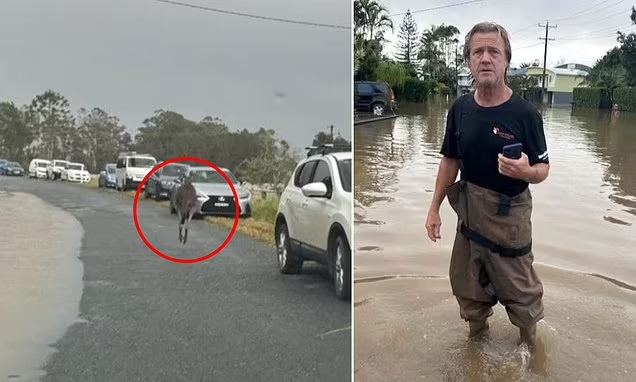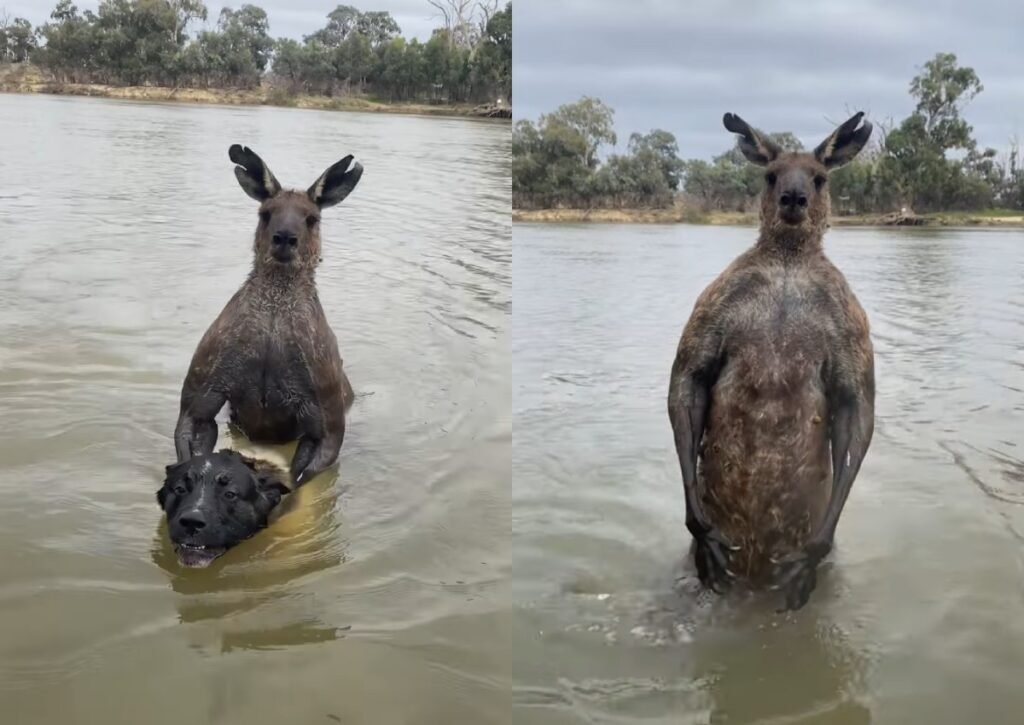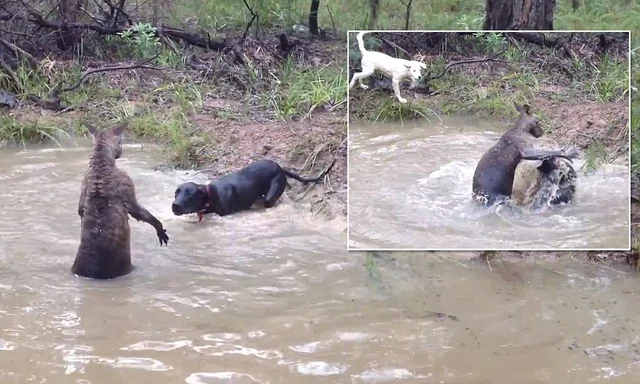Kangaroo Tries to Drown Man During Australian Flood
In a chilling and unexpected incident amid the devastating floods in New South Wales, Australia, a man named Don James found himself fighting for his life—against a kangaroo. The surreal encounter occurred near Port Macquarie, where floodwaters had pooled along a road, transforming the area into a precarious landscape for both humans and wildlife. The kangaroo, described as exceptionally muscular and aggressive, allegedly tried to drown the man during the altercation.

This unusual confrontation between human and marsupial sheds light on how natural disasters can unsettle animals and push them into unfamiliar or aggressive behavior. The shocking ordeal was witnessed by local residents who were checking the flood levels in the region.
Floods Trigger Dangerous Animal Encounters in New South Wales
New South Wales has experienced record rainfall in recent weeks, leading to severe flooding that has displaced residents and wildlife alike. Port Macquarie, a coastal town known for its beaches and rich fauna, became a focal point of both environmental destruction and human resilience.

The floodwaters not only swept through roads and homes but also disturbed native animal habitats, leading to unexpected encounters. One of the most alarming involved a kangaroo tries to drown man—a terrifying moment when Don James was attacked by a large male kangaroo amid rising waters. This incident underscores the unpredictable and dangerous outcomes of human-wildlife interaction during natural disasters.
The Lead-Up: How a Flood Check Ended When Kangaroo Tries to Drown Man
On a flood inspection drive around 9:00 AM local time, Kristy Lees and her husband were checking the water levels around Port Macquarie’s North Shore. They encountered two men, one of whom was Don James, who warned them of a large kangaroo nearby.

The animal was reportedly “as big as a car” and highly agitated. According to Lees, the kangaroo initially charged her vehicle but quickly shifted its focus upon spotting James, who was walking up the road. The marsupial then began a rapid pursuit, leading to what witnesses described as a full-blown boxing match.
A Punch-Up Turns Perilous: Kangaroo Tries to Drown Man in Floodwaters
The physical clash escalated quickly. James stumbled and fell into a roadside floodwater patch. Witnesses said the kangaroo pinned him down and tried to hold him underwater.
Kristy Lees, watching from her car’s rear-view mirror, immediately realized the seriousness of the situation. She directed her husband to help, though the incident concluded before intervention was needed—the kangaroo became startled by an approaching car and bolted away, leaving James shaken but alive.
Don James Recalls the Terrifying Kangaroo Attack During Flood
James described the incident as one of the most traumatic experiences of his life. “All I remember is being underwater, kicking, screaming, trying to breathe,” he said. The moment when the kangaroo tries to drown man was not only surreal but terrifying. James felt completely helpless and believed the kangaroo was deliberately trying to kill him.

Even more incredibly, James revealed this wasn’t his first encounter with a deadly animal. Just a year earlier, he had reportedly fended off a great white shark. His chilling but slightly humorous reflection: “I feel like they’re trying to kill me, all these animals.”
Why Would a Kangaroo Try to Drown a Man During Floods?
Experts say that kangaroos will often flee into water when threatened. Their natural instinct in such situations is to draw predators into the water, where they attempt to use their strong forelimbs to hold the threat under.
Ecologists suggest that this behavior is a self-defense mechanism rather than a calculated attack. Nevertheless, the danger to humans caught in these situations is very real. Kangaroos are powerful animals, and in flood conditions, the risk multiplies.
Understanding Kangaroo Behavior During Natural Disasters
Kangaroos are usually non-aggressive, but environmental stress—such as floods, bushfires, or habitat loss—can alter their behavior significantly. In this case, the floodwaters may have disoriented the kangaroo or confined it to a limited space, causing it to become territorial or panicked.
Human presence in such situations can be perceived as a threat, even if unintentional. As kangaroos are capable of inflicting serious harm with their strong legs and sharp claws, interactions should be avoided unless necessary.
How Climate Change Is Influencing Human-Wildlife Conflicts in Australia
This incident is not just about one kangaroo and one man—it’s emblematic of a broader issue. Climate change is increasing the frequency and severity of extreme weather events in Australia, including floods and bushfires. These changes are disrupting ecosystems, driving animals into urban areas, and increasing the likelihood of human-wildlife conflicts.
With rising global temperatures, such encounters may become more common. Floods can destroy animal habitats, and displaced wildlife can act unpredictably when stressed or threatened.
Public Safety Measures: What To Do If You Encounter a Kangaroo
Australian authorities advise the public to stay inside vehicles and avoid approaching kangaroos, particularly during or after natural disasters. If a kangaroo does approach or attack:
- Remain calm and avoid eye contact.
- Do not run—move slowly away if possible.
- If knocked to the ground, curl up into a ball to protect vital organs.
- Do not attempt to fight back; kangaroos are incredibly strong and can inflict serious injury.
Emergency Response and Community Awareness
After the incident, Kristy Lees took it upon herself to alert neighbors and other locals about the aggressive kangaroo, ensuring people in the vicinity were aware and cautious. This type of community vigilance is crucial in disaster scenarios, where emergency services may be stretched thin.
Local wildlife services were later informed to monitor the kangaroo’s movements, although no further aggressive incidents were reported.
Australia’s Struggle with Natural Disasters: A Continuing Saga
Australia is no stranger to natural calamities, and each brings a fresh wave of complications. Whether it’s wildfires forcing koalas into city streets or floods causing kangaroos to become aggressive, the nation must continually adapt its emergency response to include animal behavior.
Conservation efforts must also consider these shifts, ensuring both human safety and animal welfare are prioritized.
Voices from the Community: Reactions to the Kangaroo Attack
The event sparked a range of reactions—from disbelief to dark humor. Social media users expressed shock, while others joked about the idea of a kangaroo practicing martial arts. Still, for Don James and witnesses like Kristy Lees, the moment was far from funny.
“I’ve lived here all my life and never seen anything like it,” said a local resident. “It’s a reminder that nature doesn’t play by the rules.”
A Tale of Survival in a Changing Landscape
The bizarre and terrifying encounter in Port Macquarie is a powerful reminder of the unexpected dangers that can arise when human activity intersects with displaced wildlife—especially during extreme weather events. While kangaroos are an iconic part of Australia’s identity, they are also wild animals with instincts that can be unpredictable under stress.
Don James’s survival story is as unusual as it is frightening, and it underscores the need for preparedness—not just for floods and storms, but also for the wildlife that might be pushed into our paths by nature’s fury.



